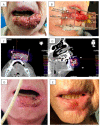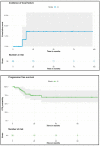Pulsed Dose Rate Brachytherapy of Lip Carcinoma: Clinical Outcome and Quality of Life Analysis
- PMID: 33808535
- PMCID: PMC8003123
- DOI: 10.3390/cancers13061387
Pulsed Dose Rate Brachytherapy of Lip Carcinoma: Clinical Outcome and Quality of Life Analysis
Abstract
Purpose: Lip carcinoma represents one of the most common types of head and neck cancer. Brachytherapy is a highly effective therapeutic option for all stages of lip cancers. We report our experience of pulsed dose rate brachytherapy (PDR) as treatment of lip carcinoma.
Methods and materials: this retrospective single center study included all consecutive patients treated for a lip PDR brachytherapy in our institution from 2010 to 2019. The toxicities and outcomes of the patients were reported, and a retrospective quality of life assessment was conducted by phone interviews (FACT H&N).
Results: From October 2010 to December 2019, 38 patients were treated in our institution for a lip carcinoma by PDR brachytherapy. The median age was 73, and the majority of patients presented T1-T2 tumors (79%). The median total dose was 70.14 Gy (range: 60-85 Gy). With a mean follow-up of 35.4 months, two patients (5.6%) presented local failure, and seven patients (19%) had lymph node progression. The Kaplan-Meier estimated probability of local failure was 7.2% (95% CI: 0.84-1) at two and four years. All patients encountered radiomucitis grade II or higher. The rate of late toxicities was low: three patients (8.3%) had grade II fibrosis, and one patient had grade II chronic pain. All patients would highly recommend the treatment. The median FACT H&N total score was 127 out of 148, and the median FACT H&N Trial Outcome Index was 84.
Conclusions: This study confirms that an excellent local control rate is achieved with PDR brachytherapy as treatment of lip carcinoma, with very limited late side effects and satisfactory functional outcomes. A multimodal approach should help to improve regional control.
Keywords: brachytherapy; lip cancer; pulsed dose rate; quality of life; radiation therapy; radiotherapy.
Conflict of interest statement
The authors declare that the research was conducted in the absence of any commercial or financial relationships that could be construed as a potential conflict of interest.
Figures




Similar articles
-
Long term results of a prospective dose escalation phase-II trial: interstitial pulsed-dose-rate brachytherapy as boost for intermediate- and high-risk prostate cancer.Radiother Oncol. 2012 Aug;104(2):181-6. doi: 10.1016/j.radonc.2012.07.003. Epub 2012 Jul 30. Radiother Oncol. 2012. PMID: 22853851 Clinical Trial.
-
Pulsed dose rate brachytherapy of lip cancer.J Contemp Brachytherapy. 2013 Sep;5(3):144-7. doi: 10.5114/jcb.2013.37777. Epub 2013 Sep 20. J Contemp Brachytherapy. 2013. PMID: 24143149 Free PMC article.
-
Adjuvant interstitial three-dimensional pulse-dose-rate-brachytherapy for lip squamous cell carcinoma after surgical resection.J Contemp Brachytherapy. 2019 Apr;11(2):116-121. doi: 10.5114/jcb.2019.84687. Epub 2019 Apr 29. J Contemp Brachytherapy. 2019. PMID: 31139219 Free PMC article.
-
Pilot study in the treatment of endometrial carcinoma with 3D image-based high-dose-rate brachytherapy using modified Heyman packing: clinical experience and dose-volume histogram analysis.Int J Radiat Oncol Biol Phys. 2005 Jun 1;62(2):468-78. doi: 10.1016/j.ijrobp.2004.10.013. Int J Radiat Oncol Biol Phys. 2005. PMID: 15890589 Review.
-
High-dose-rate brachytherapy in the treatment of recurrent and residual head and neck cancer.Laryngoscope. 2002 Aug;112(8 Pt 1):1366-71. doi: 10.1097/00005537-200208000-00008. Laryngoscope. 2002. PMID: 12172246 Review.
Cited by
-
High-Dose-Rate Brachytherapy for Treatment of Facial Skin Cancers: Local Control, Toxicity, and Quality of Life in 67 Patients.Cancers (Basel). 2024 Aug 1;16(15):2742. doi: 10.3390/cancers16152742. Cancers (Basel). 2024. PMID: 39123471 Free PMC article.
-
Individualized 3D-printed applicators for magnetic resonance imaging-guided brachytherapy in nasal vestibule cancer.Phys Imaging Radiat Oncol. 2024 Aug 17;31:100629. doi: 10.1016/j.phro.2024.100629. eCollection 2024 Jul. Phys Imaging Radiat Oncol. 2024. PMID: 39257571 Free PMC article.
-
Reirradiation Practice in Gynecological Cancer: Insights from a National Survey in Spain.Clin Transl Oncol. 2025 Jun;27(6):2494-2501. doi: 10.1007/s12094-024-03804-x. Epub 2024 Dec 5. Clin Transl Oncol. 2025. PMID: 39636497
-
High dose interstitial brachytherapy for treatment of carcinoma of the lip as an alternative to surgery: a case report.Ecancermedicalscience. 2021 Sep 30;15:1297. doi: 10.3332/ecancer.2021.1297. eCollection 2021. Ecancermedicalscience. 2021. PMID: 34824620 Free PMC article.
-
"High-risk" tumors of the lip treated with external beam radiotherapy and high-dose-rate brachytherapy: Long-term outcome.Head Neck. 2025 Feb;47(2):586-598. doi: 10.1002/hed.27936. Epub 2024 Sep 26. Head Neck. 2025. PMID: 39327222 Free PMC article.
References
-
- van Leeuwen M.T., Grulich A.E., McDonald S.P., McCredie M.R.E., Amin J., Stewart J.H., Webster A.C., Chapman J.R., Vajdic C.M. Immunosuppression and other risk factors for lip cancer after kidney transplantation. Cancer Epidemiol. Biomark. 2009;18:561–569. doi: 10.1158/1055-9965.EPI-08-0919. - DOI - PubMed
-
- Gerbaulet A., Pötter R., Mazeron J.-J., Meertens H., Limbergen E., Mazeron J.-J. The GEC ESTRO Handbook of Brachytherapy. ACCO; Leuven, Belgium: 2002.
LinkOut - more resources
Full Text Sources
Other Literature Sources

